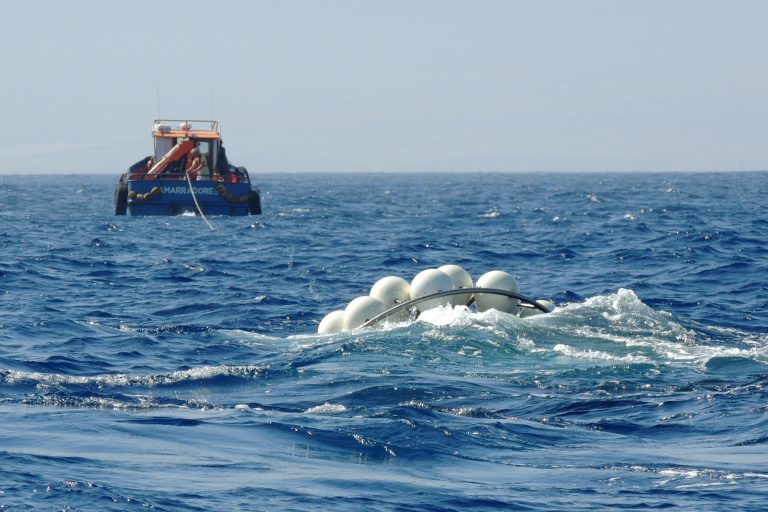Deep-water boost for a community exposed to ocean change
Mesocosm experiment on the effects of ocean acidification at its summit

In a long-term field study led by GEOMAR Helmholtz Centre for Ocean Research Kiel, an international team of scientists investigates the effects of ocean acidification on pelagic ecosystems in the subtropical Atlantic. The field experiment with the KOSMOS mesocosms off Gran Canary now culminates in the simulation of deep-water upwelling – an event that can boost productivity in these nutrient-starving waters. For this purpose, the researchers developed an 80,000 litres deep-water collector.
How do communities in the nutrient-poor, so-called oligotrophic open ocean react, if the seawater gradually acidifies due to the uptake of human-induced carbon dioxide (CO2)? How are elemental fluxes and interactions in the food web affected, if these high-CO2 exposed communities experience an influx of nutrient-rich deep-water? In a large-scale field experiment, 53 scientists from Germany, Spain, France, Great Britain and the United States are investigating how ocean acidification influences important functions in an ecosystem representative for two-thirds of the world’s oceans. For this experiment, the two German research networks BIOACID (Biological Impacts of Ocean Acidification) and SOPRAN (Surface Ocean Processes in the Anthropocene) cooperate with the Spanish research station Plataforma Oceánica de Canarias (PLOCAN) and the University of Las Palmas de Gran Canaria (ULPGC).
“Earlier experiments focused on highly productive nutrient-rich coastal areas”, says Ulf Riebesell, Professor of Biological Oceanography at GEOMAR Helmholtz Centre for Ocean Research Kiel. “To make reliable predictions about the future ocean, we need to learn more about how these nutrient-poor ecosystems respond to ocean change.” To achieve this goal, a team of marine scientists, engineers and technicians headed by Prof. Riebesell deployed nine KOSMOS (Kiel Off-Shore mesocosms for Future Ocean Simulations) mesocosms off Gran Canary. With the help of the Spanish research vessel HESPERIDES the experimental platforms were moored in the Bahia de Gando. The “giant test tubes”, each enclosing 40,000 litres of seawater, were then enriched in carbon dioxide to levels covering the range from present day values to those projected for the year 2150.
At the start of the experiment in late September, the conditions were truly oligotrophic: “The nutrient concentrations were hardly above the detection limit, and the plankton community was dominated by tiny algal cells and microzooplankton species. The water was crystal clear,” Prof. Riebesell recalls. Occasionally, upwelling events increase the productivity in these ocean deserts: Oceanic eddies transport deep-water containing high concentrations of nitrate, phosphate and silicate, towards the surface. “Such nutrient infusions act like heavy rain falls on a dry savannah: Life flourishes for a short period of time,” explains Prof. Riebesell. “So far it’s completely unclear how these productivity hotspots are affected by ocean acidification and what are the impacts on the oceanic food web.”
To simulate such a boost, the KOSMOS team developed a deep-water collector with the help of the Technology and Logistics Centre of GEOMAR. Five nautical miles off the coast of Gran Canary they collected 80,000 litres of water at a depth of 650 meters in a giant plastic balloon and towed it to their study site. After adding the deep-water to the enclosed ecosystems, the researchers increased the frequency of their measurements to obtain a detailed insight into the responses of the CO2-stressed communities. Their observations will be the first to shed light on the impacts of ocean acidification on the nutrient-poor open, the largest ecosystem on our planet.
The scientists report regularly about their work on the Kiel blog platform Oceanblogs.
Institutions involved:
University of Las Palmas de Gran Canaria, Spain
Alfred Wegener Institute, Helmholtz Centre for Polar and Marine Research (AWI), Bremerhaven, Germany
Carl von Ossietzky University Oldenburg, Germany
GEOMAR Helmholtz Centre for Ocean Research Kiel, Germany
Leibniz Institute for Baltic Sea Research Warnemünde (IOW), Germany
Leibniz Institute of Freshwater Ecology and Inland Fisheries, Berlin (IGB), Germany
Max Planck Institute for Chemistry, Mainz, Germany
Bigelow Laboratory, Maine, USA
European Centre for Research and Education in Environmental Geosciences (CEREGE), Paris, France
University of Edinburgh, United Kingdom